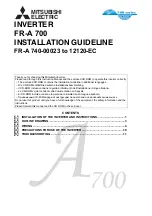
10
3.3 Control circuit terminals
3.3.1 Terminal layout
3.3.2 Instructions for wiring of the control circuit terminal
Terminals PC, 5, and SE are all common terminals (0V) for I/O signals and are isolated from each other. Avoid
connecting the terminal PC and 5 and the terminal SE and 5 (ground). Terminal PC is a common terminal for the contact
input terminals (STF, STR, STOP, RH, RM, RL, JOG, RT, MRS, RES,AU, CS).
Use shielded or twisted cables for connection to the control circuit terminals and run them away from the main and
power circuits (including the 230V relay sequence circuit)..
Use two or more parallel micro-signal contacts or twin
contacts to prevent a contact faults when using contact
inputs since the control circuit input signals are micro-
currents.
Do not apply a voltage to the contact input terminals (e.g. STF) of the control circuit.
Always apply a voltage to the alarm output terminals (A, B, C) via a relay coil, lamp, etc.
It is recommended to use the cables of 0.75mm
2
gauge for connection to the control circuit terminals.
If the cable gauge used is 1.25mm
2
or more, the front cover may be lifted when there are many cables running or the
cables are run improperly, resulting in an operation panel contact fault.
The wiring length should be 30m maximum.
The level of the control signals can be switched over between positive (SOURCE) and negative (SINK) logic. The input
signals are set to source logic when shipped from the factory. To change the control logic, the jumper connector on the
control circuit terminal block must bemoved to the other position.
STOP
AU
RH
RM
RL
C2
B2
A2
C1
B1
A1
OL
IPF
SU
RUN
SE
1
4
5
2
10
10E
AM
PC
FU MRS JOG CS
RES STF STR PC
CA SD PC
RT
Micro signal contacts
Zwillingskontakte
Summary of Contents for 700 Series
Page 18: ...14 TROUBLESHOOTING ...










































